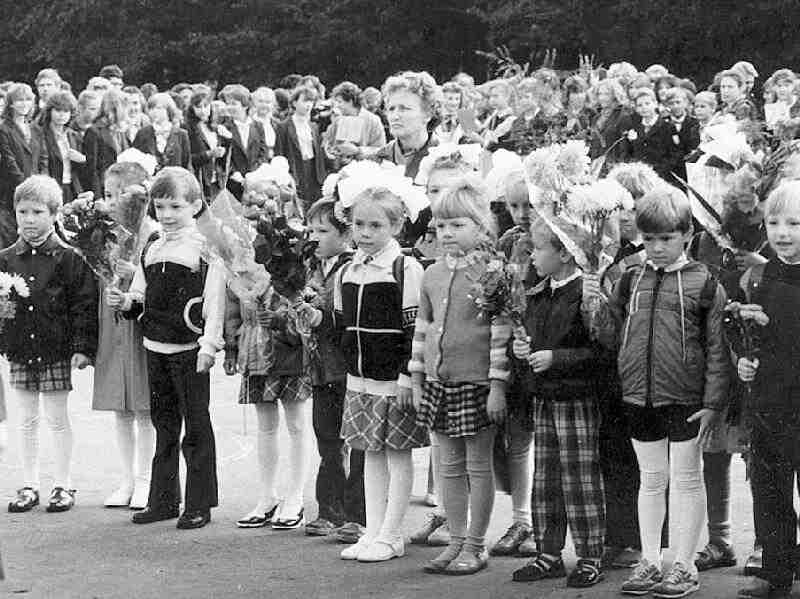
Soviet School Uniform: Post Stalinist Era--School Levels

Figure 1.--This is a First Day photograph of First Graders in 1988. They do not seem to be wearing uniforms. In the last years of the Soviet Union, school uniform regulations became more lax. The girls have fancy hair bows. It would have been taken September 1.
|
|
We have begun to collect some chronological information on primary and secondary schools over time. Uniforms seem to have become well established at Soviet schools during the late Stalinist era and this was continued into the post-Stalinist era. The uniforms seem to have been basically the same at both primary and secondary schools, although the older secondary students were given some alternatives. The basic difference seems to be that some of the primary boys wore short pants. We note that by the mid-80s that some schools were not as strictly enforcing the uniform rules. There also appears to be a degree of variation. This seems to have been regional or perhaps city differences.
The Soviet model of Kindergarten provided nursery care, preschool, and kindergarten for children from 3 months to 6 years of age when they entered the first grade. The pre-schools unlike regular schools were not compulsory. Nor were they universally available or free, although the fees were very low and adjusted for family income. There were two levels of pre-school. Nursery schools for the younger chikldren and Kindergartens for the older children. There was no national system of pre-schools. Rather they were set up by work units (factories, state farms, soviets (municipalities) , and, government agencies. The operating hours were flexible to meet the needs of working parents. City preschools commonly open from 7-8 AM to 6-7 pm. More than half operated on Saturday which was often a work day. The rest operted 5 days a week. Most of these schools, except for the ones sponsored by state farms, were in cities. One source reports that about 23 percent of Soviet children attended pre-schools in 1965. At about this time, the Soviets made a major effort to open pre-schools in rural areas. By the mid-80s about 25 percent of rural children were also enrolled in pre-schools.
The rural schools often differed in operating schedules. Pre-schools were expected to provide the children with a healthy environment which their parents worked. They were supervised and fed. Therecwere arts activities, play and rest times. The quality of the dschools varied. Staffs might include a nurse and access to a doctor on a part-time basis. At least one teacher with university-level training in pre-school education was commonly assgned to these schools. Most of the teachers were graduates of secondary-level vocational schools. [Eaton, pp. 212-212.]
Primary Schools
Girls in grades 1-8 wore a brown dress with a black pinafore style-apron in front. Another source says a dark-blue or black dress with an Edwardian style pinafore white apron. Apparently the dress colors varied somewhat. On holidays the black apron was replaced by a dressier white pinafore which might be frilled. At the top of the dress, girls wore a white collar, often in the Peter Pan style, which could be detached and washed separately. Girls or their parents often added large white hairbows. The collar was expected to be kept spotlessly clean. The younger boys sometimes wore large white collars over their jackets, but this varied from school to school and over time.
Secondary Schools
In grades 9-10 the uniform changed to a navy blue jacket and skirt which could be combined with a blouse of the girl's own choice. Boys wore a still obligatory, but more civilian-looking uniform. It consisted of dark blue pants, short jacket with chevron (image of the book on a background of the sun), white shirt, and red scarf.
Sources
Eaton, Katherine Bliss. Daily Life in the Soviet Union (2004), 230, p..
HBC-SU

Related Chronolgy Pages in the Boys' Historical Web Site
[Main Chronology Page]
[The 1900s]
[The 1910s]
[The 1920s]
[The 1930s]
[The 1940s]
[The 1950s]
[The 1960s]
[The 1970s]
Navigate the Relate Boys Historical Clothing Style Pages
[Return to the Main country page]
[Return to the Main Russian page]
[Long pants suits]
[Short pants suits]
[Lederhosen]
[Kneesocks]
[Eton suits]
[Jacket and trousers]
[Blazer
[School sandals]
Navigate the HBC Country School Pages:
[Return to the Main Soviet post-Stalinist school page]
[Return to the Main School Uniform Page]
[Return to the Main National School Uniform Page]
[Australia]
[England]
[France]
[Germany]
[Ireland]
[Italy]
[Japan]
[New Zealand]
[The Philippines]
[Poland]
[Scotland]
[South Africa]
[United States]
Navigate the HBC School Sections:
[About Us]
[Activities]
[Chronology]
[Clothing styles]
[Countries]
[Debate]
[Economics]
[Garment]
[Gender]
[Hair]
[History]
[Home trends]
[Literary characters]
[School types]
[Significance]
[Transport and travel
[Uniform regulations]
[Year level]
[Other topics]
[Images]
[Links]
[Registration]
[Tools]
[Return to the Historic Boys' School Home]
Created: 3:25 AM 10/7/2008
Last updated: 6:41 PM 1/3/2009




